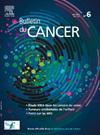Actualités sur la leucémie à tricholeucocytes
IF 1.1
4区 医学
Q4 ONCOLOGY
引用次数: 0
Abstract
Les proliférations à cellules chevelues représentent des entités différentes incluant la leucémie à tricholeucocytes dans sa forme classique, une entité bien définie mais aussi la forme variante de la leucémie à tricholeucocytes (LT-V), dont la présentation est éloignée de la leucémie à tricholeucocytes et dont le pronostic est plus réservé. Les autres proliférations à cellules chevelues comprennent le lymphome splénique diffus de la pulpe rouge de la rate et les lymphomes spléniques de la zone marginale avec cellules villeuses circulantes. Dans cet article, nous insistons sur les nouveautés, concernant les aspects biologiques récents de la leucémie à tricholeucocytes notamment les présentations cliniques inhabituelles de la maladie mais aussi l’importance de la détection de la mutation BRAFV600E, marqueur moléculaire de la maladie. D’autres mutations non canoniques doivent être identifiées en raison d’une possible contre-indication à utiliser les inhibiteurs de BRAF. La présence d’un profil non muté des chaînes lourdes des immunoglobulines (IGHV), observé dans 20 % des cas est associée à un mauvais pronostic. Nous apportons aussi une aide à caractériser les autres proliférations à cellules chevelues, lors de l’examen du frottis sanguin. Le traitement de première ligne de la leucémie à tricholeucocytes s’est récemment modifié et l’immunochimiothérapie associant cladribine plus rituximab est devenu le gold standard. Dans les formes en rechute ou réfractaires, les autres traitements sont à discuter en réunion de concertation pluridisciplinaire et associent les inhibiteurs de BRAF associés aux anticorps anti-CD20, aux inhibiteurs de BTK ou les inhibiteurs de Bcl-2. Les choix sont à discuter en fonction du profil du patient mais aussi de son profil biologique.
Hairy cell proliferations represent very different entities. They include hairy cell leukemia in its classic form (HCL), a well-defined entity, but also the variant form of HCL (LT-V ou HCL-V), whose presentation is far from HCL and whose prognosis is poorer. Other hairy cell proliferations include splenic red pulp lymphoma (SDRPL) and splenic marginal zone lymphomas (SMZL) with circulating villous cells. In this article, we emphasize the novelties concerning the different recent biological aspects of HCL, including the unusual clinical presentations but also the importance for the diagnosis of the detection of the BRAFV600E mutation, a molecular marker of the disease, and the presence of other non-canonical mutations that should be identified because of the contraindication to the use of BRAF inhibitors. Finally, the presence of a non-mutated profile of immunoglobulin heavy chains (IGHV), observed in 20% of cases, is associated with a poor prognosis. We also provide guidance in characterizing other hairy cell proliferations when examining the blood smear. The first-line treatment of HCL has recently changed and immunochemotherapy combining cladribine plus rituximab has become the gold standard. In relapsed or refractory forms, other treatments should be discussed in a multidisciplinary consultation meeting and combine BRAF inhibitors with anti-CD20 antibodies, BTK inhibitors or Bcl-2 inhibitors. The choices should be discussed according to the patient's profile but also their biological profile.
[毛细胞白血病(HCL)和HCL样疾病的最新进展]。
毛细胞增殖代表了非常不同的实体。它们包括毛细胞白血病的经典形式(HCL),一种定义明确的实体,但也包括HCL的变体形式(LT-V或HCL- v),其表现与HCL相差甚远,预后较差。其他毛细胞增生包括脾红髓淋巴瘤(SDRPL)和脾边缘带淋巴瘤(SMZL)伴循环绒毛细胞。在这篇文章中,我们强调了关于HCL不同的近期生物学方面的新颖性,包括不寻常的临床表现,以及诊断检测BRAFV600E突变(该疾病的分子标记)的重要性,以及由于使用BRAF抑制剂的禁忌症而应识别的其他非典型突变的存在。最后,在20%的病例中观察到免疫球蛋白重链(IGHV)的非突变谱的存在与预后不良有关。当检查血液涂片时,我们也提供了其他毛细胞增殖特征的指导。HCL的一线治疗方法最近发生了变化,免疫化疗联合克拉德滨和美罗华已成为金标准。对于复发或难治性形式,应在多学科会诊会议上讨论其他治疗方法,并将BRAF抑制剂与抗cd20抗体、BTK抑制剂或Bcl-2抑制剂联合使用。应该根据病人的情况和他们的生物学情况来讨论选择。
本文章由计算机程序翻译,如有差异,请以英文原文为准。
求助全文
约1分钟内获得全文
求助全文
来源期刊

Bulletin Du Cancer
医学-肿瘤学
CiteScore
1.90
自引率
16.70%
发文量
224
审稿时长
37 days
期刊介绍:
Without doubt, the ''Bulletin du Cancer'' is the French language publication of reference in the field of cancerology. Official organ of the French Society of Cancer, this journal covers all the information available, whether in the form of original articles or review articles, but also clinical cases and letters to the editor, including various disciplines as onco-hematology, solids tumors, medical oncology, pharmacology, epidemiology, biology as well as fundamental research in cancerology. The journal proposes a clinical and therapeutic approach of high scientific standard and regular updates in knowledge are thus made possible. Articles can be submitted in French or English.
 求助内容:
求助内容: 应助结果提醒方式:
应助结果提醒方式:


